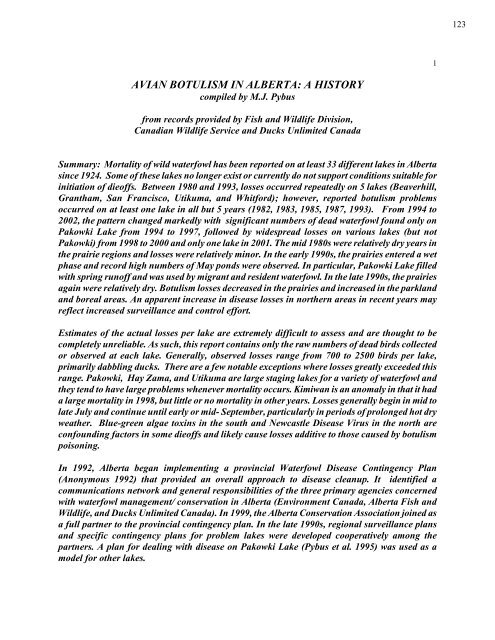Ecology and Management of Avian Botulism on the Canadian Prairies
Ecology and Management of Avian Botulism on the Canadian Prairies
Ecology and Management of Avian Botulism on the Canadian Prairies
You also want an ePaper? Increase the reach of your titles
YUMPU automatically turns print PDFs into web optimized ePapers that Google loves.
1231AVIAN BOTULISM IN ALBERTA: A HISTORYcompiled by M.J. Pybusfrom records provided by Fish <str<strong>on</strong>g>and</str<strong>on</strong>g> Wildlife Divisi<strong>on</strong>,<strong>Canadian</strong> Wildlife Service <str<strong>on</strong>g>and</str<strong>on</strong>g> Ducks Unlimited CanadaSummary: Mortality <str<strong>on</strong>g>of</str<strong>on</strong>g> wild waterfowl has been reported <strong>on</strong> at least 33 different lakes in Albertasince 1924. Some <str<strong>on</strong>g>of</str<strong>on</strong>g> <strong>the</strong>se lakes no l<strong>on</strong>ger exist or currently do not support c<strong>on</strong>diti<strong>on</strong>s suitable forinitiati<strong>on</strong> <str<strong>on</strong>g>of</str<strong>on</strong>g> die<str<strong>on</strong>g>of</str<strong>on</strong>g>fs. Between 1980 <str<strong>on</strong>g>and</str<strong>on</strong>g> 1993, losses occurred repeatedly <strong>on</strong> 5 lakes (Beaverhill,Grantham, San Francisco, Utikuma, <str<strong>on</strong>g>and</str<strong>on</strong>g> Whitford); however, reported botulism problemsoccurred <strong>on</strong> at least <strong>on</strong>e lake in all but 5 years (1982, 1983, 1985, 1987, 1993). From 1994 to2002, <strong>the</strong> pattern changed markedly with significant numbers <str<strong>on</strong>g>of</str<strong>on</strong>g> dead waterfowl found <strong>on</strong>ly <strong>on</strong>Pakowki Lake from 1994 to 1997, followed by widespread losses <strong>on</strong> various lakes (but notPakowki) from 1998 to 2000 <str<strong>on</strong>g>and</str<strong>on</strong>g> <strong>on</strong>ly <strong>on</strong>e lake in 2001. The mid 1980s were relatively dry years in<strong>the</strong> prairie regi<strong>on</strong>s <str<strong>on</strong>g>and</str<strong>on</strong>g> losses were relatively minor. In <strong>the</strong> early 1990s, <strong>the</strong> prairies entered a wetphase <str<strong>on</strong>g>and</str<strong>on</strong>g> record high numbers <str<strong>on</strong>g>of</str<strong>on</strong>g> May p<strong>on</strong>ds were observed. In particular, Pakowki Lake filledwith spring run<str<strong>on</strong>g>of</str<strong>on</strong>g>f <str<strong>on</strong>g>and</str<strong>on</strong>g> was used by migrant <str<strong>on</strong>g>and</str<strong>on</strong>g> resident waterfowl. In <strong>the</strong> late 1990s, <strong>the</strong> prairiesagain were relatively dry. <str<strong>on</strong>g>Botulism</str<strong>on</strong>g> losses decreased in <strong>the</strong> prairies <str<strong>on</strong>g>and</str<strong>on</strong>g> increased in <strong>the</strong> parkl<str<strong>on</strong>g>and</str<strong>on</strong>g><str<strong>on</strong>g>and</str<strong>on</strong>g> boreal areas. An apparent increase in disease losses in nor<strong>the</strong>rn areas in recent years mayreflect increased surveillance <str<strong>on</strong>g>and</str<strong>on</strong>g> c<strong>on</strong>trol effort.Estimates <str<strong>on</strong>g>of</str<strong>on</strong>g> <strong>the</strong> actual losses per lake are extremely difficult to assess <str<strong>on</strong>g>and</str<strong>on</strong>g> are thought to becompletely unreliable. As such, this report c<strong>on</strong>tains <strong>on</strong>ly <strong>the</strong> raw numbers <str<strong>on</strong>g>of</str<strong>on</strong>g> dead birds collectedor observed at each lake. Generally, observed losses range from 700 to 2500 birds per lake,primarily dabbling ducks. There are a few notable excepti<strong>on</strong>s where losses greatly exceeded thisrange. Pakowki, Hay Zama, <str<strong>on</strong>g>and</str<strong>on</strong>g> Utikuma are large staging lakes for a variety <str<strong>on</strong>g>of</str<strong>on</strong>g> waterfowl <str<strong>on</strong>g>and</str<strong>on</strong>g><strong>the</strong>y tend to have large problems whenever mortality occurs. Kimiwan is an anomaly in that it hada large mortality in 1998, but little or no mortality in o<strong>the</strong>r years. Losses generally begin in mid tolate July <str<strong>on</strong>g>and</str<strong>on</strong>g> c<strong>on</strong>tinue until early or mid- September, particularly in periods <str<strong>on</strong>g>of</str<strong>on</strong>g> prol<strong>on</strong>ged hot drywea<strong>the</strong>r. Blue-green algae toxins in <strong>the</strong> south <str<strong>on</strong>g>and</str<strong>on</strong>g> Newcastle Disease Virus in <strong>the</strong> north arec<strong>on</strong>founding factors in some die<str<strong>on</strong>g>of</str<strong>on</strong>g>fs <str<strong>on</strong>g>and</str<strong>on</strong>g> likely cause losses additive to those caused by botulismpois<strong>on</strong>ing.In 1992, Alberta began implementing a provincial Waterfowl Disease C<strong>on</strong>tingency Plan(An<strong>on</strong>ymous 1992) that provided an overall approach to disease cleanup. It identified acommunicati<strong>on</strong>s network <str<strong>on</strong>g>and</str<strong>on</strong>g> general resp<strong>on</strong>sibilities <str<strong>on</strong>g>of</str<strong>on</strong>g> <strong>the</strong> three primary agencies c<strong>on</strong>cernedwith waterfowl management/ c<strong>on</strong>servati<strong>on</strong> in Alberta (Envir<strong>on</strong>ment Canada, Alberta Fish <str<strong>on</strong>g>and</str<strong>on</strong>g>Wildlife, <str<strong>on</strong>g>and</str<strong>on</strong>g> Ducks Unlimited Canada). In 1999, <strong>the</strong> Alberta C<strong>on</strong>servati<strong>on</strong> Associati<strong>on</strong> joined asa full partner to <strong>the</strong> provincial c<strong>on</strong>tingency plan. In <strong>the</strong> late 1990s, regi<strong>on</strong>al surveillance plans<str<strong>on</strong>g>and</str<strong>on</strong>g> specific c<strong>on</strong>tingency plans for problem lakes were developed cooperatively am<strong>on</strong>g <strong>the</strong>partners. A plan for dealing with disease <strong>on</strong> Pakowki Lake (Pybus et al. 1995) was used as amodel for o<strong>the</strong>r lakes.


